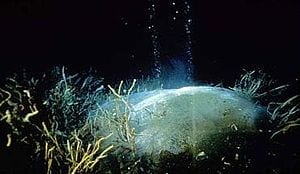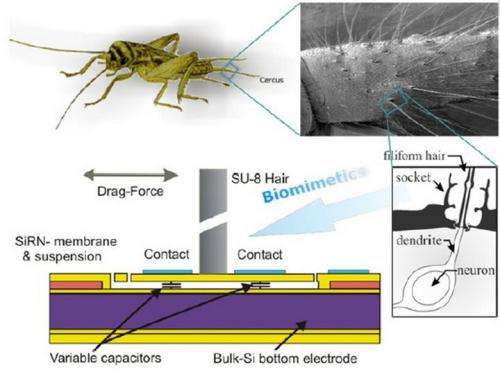
Japan said Tuesday that it had extracted gas from offshore deposits of methane hydrate — sometimes called “flammable ice” — a breakthrough that officials and experts said could be a step toward tapping a promising but still little-understood energy source.
The gas, whose extraction from the undersea hydrate reservoir was thought to be a world first, could provide an alternative source of energy to known oil and gas reserves. That could be crucial especially for Japan, which is the world’s biggest importer of liquefied natural gas and is engaged in a public debate about whether to resume the country’s heavy reliance on nuclear power.
Experts estimate that the carbon found in gas hydrates worldwide totals at least twice the amount of carbon in all of the earth’s other fossil fuels, making it a potential game-changer for energy-poor countries like Japan. Researchers had already successfully extracted gas from onshore methane hydrate reservoirs, but not from beneath the seabed, where much of the world’s deposits are thought to lie.
The exact properties of undersea hydrates and how they might affect the environment are still poorly understood, given that methane is a greenhouse gas. Japan has invested hundreds of millions of dollars since the early 2000s to explore offshore methane hydrate reserves in both the Pacific and the Sea of Japan.
That task has become all the more pressing after the Fukushima Daiichi nuclear crisis, which has all but halted Japan’s nuclear energy program and caused a sharp increase in the country’s fossil fuel imports. Japan’s rising energy bill has weighed heavily on its economy, helping to push it to a trade deficit and reducing the benefits of the recently weaker yen to Japanese exporters.
The Japanese Ministry of Economy, Trade and Industry said a team aboard the scientific drilling ship Chikyu had started a trial extraction of gas from a layer of methane hydrates about 300 meters, or 1,000 feet, below the seabed Tuesday morning. The ship has been drilling since January in an area of the Pacific about 1,000 meters deep and 80 kilometers, or 50 miles, south of the Atsumi Peninsula in central Japan.
With specialized equipment, the team drilled into and then lowered the pressure in the undersea methane hydrate reserve, causing the methane and ice to separate. It then piped the natural gas to the surface, the ministry said in a statement.
Hours later, a flare on the ship’s stern showed that gas was being produced, the ministry said.
“Japan could finally have an energy source to call its own,” said Takami Kawamoto, a spokesman for the Japan Oil, Gas and Metals National Corporation, or Jogmec, the state-run company leading the trial extraction.
The team will continue the trial extraction for about two weeks before analyzing how much gas has been produced, Jogmec said. Japan hopes to make the extraction technology commercially viable in about five years.
“This is the world’s first trial production of gas from oceanic methane hydrates, and I hope we will be able to confirm stable gas production,” Toshimitsu Motegi, the Japanese trade minister, said at a news conference in Tokyo. He acknowledged that the extraction process would still face technical hurdles and other problems.
Still, “shale gas was considered technologically difficult to extract but is now produced on a large scale,” he said. “By tackling these challenges one by one, we could soon start tapping the resources that surround Japan.”
The Latest Bing News on:
Methane hydrate
- Revolution in Methane Detection: Scientists Achieve Groundbreaking 500-Fold Sensitivity Increaseon May 5, 2024 at 1:24 pm
A research group headed by Professor Chen Chilai from the Hefei Institutes of Physical Science of the Chinese Academy of Sciences has significantly enhanced the detection sensitivity of dissolved ...
- Underwater mass spectrometry achieves 500-fold sensitivity enhancement for dissolved methane detectionon April 29, 2024 at 1:35 pm
A research team led by Prof. Chen Chilai from Hefei Institutes of Physical Science of Chinese Academy of Sciences, amplified the detection sensitivity of dissolved methane in water by over 500 times, ...
- Australia's Major Emitters May Spew Twice More Methane Than Reported: Studyon April 29, 2024 at 7:50 am
Major polluters in Australia may be spewing more than double the methane estimated in its national inventory data, according to a report from the Melbourne-based nonprofit The Superpower Institute ...
- Indian Ocean & Bay of Bengal potential CO2 sinks: IIT Madras studyon April 29, 2024 at 3:33 am
The Indian Ocean and the Bay of Bengal are potential sinks for storing large amounts of carbon dioxide (CO2), according to a study by the Indian Institute of Technology (IIT) Madras released on Monday ...
- Estimating emissions potential of decommissioned gas wells from shale sampleson April 24, 2024 at 5:00 pm
Feb. 20, 2020 — As global temperatures rise, permafrost and methane hydrates -- large reservoirs of ancient carbon -- have the potential to break down, releasing enormous quantities of the ...
- Methane hydrate: Dirty fuel or energy saviour?on April 13, 2024 at 5:00 pm
The problem is it's a hydrocarbon, but quite unlike any other we know. Otherwise known as fire ice, methane hydrate presents as ice crystals with natural methane gas locked inside. They are formed ...
- Kick-starting ancient warmingon April 12, 2024 at 10:47 am
Sources including the release of methane during the intrusion of magma into organic-rich sedimentary rocks, carbon dioxide outgassing from lava flows, and dissociation of methane gas hydrates in ...
- Explosive levels of methane have been detected near a Berkeley landfill-turned-parkon April 10, 2024 at 5:00 pm
But beneath the sprawling grasslands and charming hiking trails, decomposing waste continues to generate methane gas. That’s why the city of Berkeley operates an underground system that collects ...
- EU lawmakers adopt law to hit fossil fuel imports with methane emissions limiton April 10, 2024 at 10:30 am
BRUSSELS, April 10 (Reuters) - European Union lawmakers on Wednesday adopted a law to place methane emission limits on Europe's oil and gas imports from 2030, pressuring international suppliers to ...
- Methane from landfills is detectable from space – and driving the climate crisison April 9, 2024 at 8:44 am
Landfill trash is the third-largest source of human-caused methane pollution in the US. To fight global heating, curb waste An elusive climate menace is now easier than ever to see. In early March ...
The Latest Google Headlines on:
Methane hydrate
[google_news title=”” keyword=”methane hydrate” num_posts=”10″ blurb_length=”0″ show_thumb=”left”] [/vc_column_text]The Latest Bing News on:
Hydrate reservoir
- Could the slosh-reducing Hydroshirt revolutionize hydration for runners?on May 8, 2024 at 4:16 am
Blurring the lines between a running shirt and a hydration pack, the Hydroshirt – which has just launched a Kickstarter campaign to seek funding – is an innovative new product designed by specifically ...
- Giant reservoir ready for service as Paris 2024 Games loomon May 2, 2024 at 2:04 pm
PARIS, May 2 (Reuters) - Paris mayor Anne Hidalgo on Thursday inaugurated a colossal storage basin that will help reduce the risks of pollution in the Seine as the Olympics approach and make the ...
- How Water Levels in California's Largest Reservoir Could Change After Stormon May 2, 2024 at 10:09 am
Getty "Even though Shasta Dam is currently 96 percent full, we have enough space in the reservoir to account for the storms coming this weekend. We will not be increasing outflows based on our ...
- Hydration Guide: Your Daily Water Intake Needs Explainedon April 29, 2024 at 1:50 pm
Dehydration can lead to fatigue, spikes in blood pressure and irregular heart rate. But the rules of hydration are surprisingly slippery. There's a lot of advice out there about how much water ...
- IIT-M researchers identify oceans as potential storage sinks for CO2on April 29, 2024 at 1:05 am
Chennai: Researchers with the Indian Institute of Technology-Madras (IIT-M) have identified the Indian Ocean and Bay of Bengal as potential storage sinks for storing large amounts of carbon dioxide ...
- 1 dead after boat capsizes in Aurora Reservoiron April 22, 2024 at 12:50 pm
DENVER (KNDVR) — Aurora emergency responders reported one person died after a boat capsized in the Aurora Reservoir on Monday. Aurora Fire Rescue crews were called to the reservoir at about 9:30 ...
- The Very Best Electrolyte Powders and Mixeson April 19, 2024 at 7:09 am
For anyone exercising and sweating a lot, it’s important to not just hydrate by drinking water regularly but to replenish your electrolytes, too. In the past couple years, I got back into ...
- California's Largest Reservoir Is Almost Completely Fullon April 16, 2024 at 5:46 am
Lake Shasta, the state's largest reservoir, neared capacity last year, but began declining in the summer. This year, Lake Shasta's water levels began significantly improving in January after a ...
- Scientists retrieve rare methane hydrate samples for climate and energy studyon April 8, 2024 at 8:15 pm
A scientific drilling mission in the Gulf of Mexico has returned with 44 cores from a methane hydrate reservoir deep under the seafloor. Globally, energy-rich methane hydrates hold an estimated 15 ...
The Latest Google Headlines on:
Hydrate reservoir
[google_news title=”” keyword=”hydrate reservoir” num_posts=”10″ blurb_length=”0″ show_thumb=”left”]











